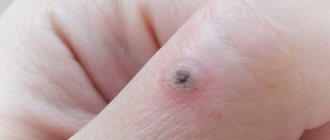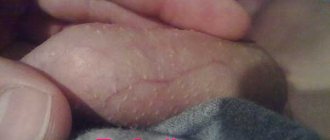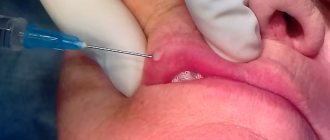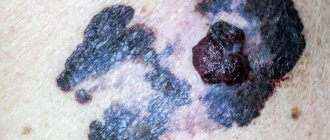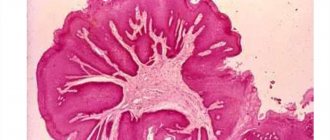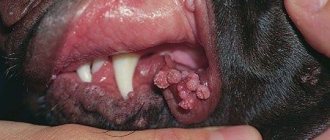Papilloma in a newborn baby is a benign neoplasm caused by the human papillomavirus (HPV). The growth consists of epithelial tissue and affects the skin or mucous membranes of the child, it can be congenital or appears in the first weeks of the baby’s life. If it is detected, parents need to contact a pediatrician or dermatologist - the doctor will make a diagnosis and, if necessary, offer treatment options. Trying to cleanse children's skin on your own is not recommended. It is better not to use folk remedies for papillomas!
Why do papillomas appear in newborns?
The main cause of the formation of neoplasms is the papillomavirus, which penetrates the child’s body through mucous tissue or damage to the skin and penetrates the structure of human cells.
The incubation period ranges from 2 weeks to several years. The infection often has a hidden, asymptomatic course for a long time, but under certain conditions, HPV activation begins, its reproduction and clinical manifestations in the form of papillomas and warts.
The main reasons that provoke the formation of papillomas in a newborn are:
- Decreased immunity of the baby, including colds;
- Pathologies of the digestive system, including dysbacteriosis and helminthiasis;
- Allergies.
Infection of a newborn can occur in several ways:
- Vertical (generic) . It involves infection of the child from the mother, which occurs during the passage of the baby through the birth canal infected with HPV. In this case, the virus can enter the infant’s respiratory tract, causing a rare form of infection - respiratory.
- Intrauterine . Another type of vertical transmission. The fact that HPV infection is possible even in the prenatal period is evidenced by the formation of papillomas in newborns and infants born as a result of cesarean section, when children did not come into contact with the birth canal of their mothers. The small size of the virus allows it to penetrate not only through the placental barrier, but even through the pores of condoms.
- Contact and household . After birth, HPV carriers, including medical personnel, with whose skin and mucous membranes the child comes into contact, can infect the baby. Infection can be transmitted through dirty tools, dishes, toys, personal hygiene items - towels, clothes.
- Autoinoculation (self-infection) . The transfer of virus elements from one part of the body to another occurs when a child scratches existing papillomas or licks his fingers.
The main causes of papillomas on the lips in children
The main cause of papillomas on a child’s lips is HPV. Infection with papillomavirus does not always manifest itself in the form of growths on the lips. This is, as a rule, an unpredictable process: for a long time, HPV can remain latent in the child’s blood and become active only under favorable conditions for the pathogen.
The latter should be understood as a weakened immune system, long-term use of antibiotics, hypothermia, nervous strain, fatigue, gastrointestinal disturbances and other factors.
In the case of children, the pathogen is transmitted through contact and household contact - in places with large crowds of people (swimming pools, gyms, schools, kindergartens), as well as through failure to comply with personal hygiene rules (using someone else's dishes, hygiene supplies). Less commonly, the virus is transmitted from mother to child during pregnancy or childbirth.
After infection with HPV, quite a long time must pass before papillomas appear on the child’s lips. Usually - from several months to several years. As a rule, the first symptoms of the disease appear six months after infection.
In general, the speed of manifestation of the disease depends on the general immune response of the child’s body - the stronger it is, the less likely it is that growths will appear on the body.
It is worth remembering that it is impossible to completely protect a child from HPV. Today in the world, according to various sources, this pathogen is present in the blood of 90% of the population. Therefore, the risk of infection is very high.
The main types of papillomas in newborns and infants
The photo shows papillomas in newborns and infants in different parts of the body
In newborns and infants, papillomas can affect the skin of any part of the head and body, including the eyelids, ears and fingers. Also, growths are localized on the mucous membranes of the nose, in the oral cavity and on the tonsils, found in bronchoalveolar lavage (washes from the bronchi and alveoli of the lungs), the anogenital area, on the cervix and in the vagina. They can be single or group, have a diameter from 1-2 mm to 2-5 cm, and are capable of growing.
The following types of papillomas are diagnosed in newborns and infants:
- Acrochords (filamentous) . Most often they are congenital. They are located one at a time or in groups on the skin anywhere, but more often on the face and neck, in the armpits, and inguinal folds. Small formations standing on thin stalks often go unnoticed and come off when rubbed with laundry or during hygiene procedures, releasing droplets of blood.
- Vulgar (simple) . Small round growths with a dense rough surface. The favorite location for simple papillomas in a newborn baby is the knees, buttocks, and the backs of the hands. See what vulgar papillomas look like.
- Flat . Dense flesh-colored formations, slightly raised above the skin, not forming a stalk. Their appearance in babies is accompanied by itching, leading to scratching of the skin and inflammation. Read about the symptoms of flat papillomas.
- Plantar . Typical for older children who can already walk. They are localized on the sole of the foot and look like yellowish lumps with dark dots inside, resembling a callus. They cause pain and discomfort when walking, and can merge, spreading over large areas. Read how to remove a plantar wart.
- Epithelial hyperplasia . With this form of papillomatosis, small papillary formations affect the oral mucosa - the walls of the cheeks, palate, tongue. During eating, papillomas in infants are often damaged and inflamed, causing pain.
- Juvenile laryngeal papillomatosis . A condition in which nodular and papillary growths affect the glottis area and the back wall of the larynx. The airways are constantly irritated and may become swollen, speech impaired, and suffocated. It is considered a rare, but serious, life-threatening disease characteristic of babies born from an infected mother. Detected before the age of 1 year.
- Warty dysplasia . It primarily affects children aged 3 years and older. Rough, red-brown spots may appear on the hands, feet, and fingers. Most often, the rashes are multiple and may merge. The disease is quite rare, but dangerous - 30% of such formations eventually become malignant tumors.
Usually, papilloma in a newborn baby does not cause pain or any discomfort. However, scratching and injury by clothing provokes the addition of a bacterial infection and inflammation, as well as the spread of rashes. If the tumor is located in the folds of the groin or in the anus, the baby's bowel movements can lead to irritation and ulceration of the growth. To avoid such complications, it is necessary to pay due attention to the hygiene of the child’s genital organs.
Methods for treating papillomas in newborns
Papilloma in an infant or newborn child does not always require urgent therapeutic measures. Most often, the doctor suggests simply observing the tumor for some time (1.5-2 years) without injuring it, and periodically performing repeated screenings. In childhood and adolescence, the likelihood of self-healing from HPV is high. If the growth does not disappear or, on the contrary, new elements appear, resort to the following treatment methods.
Conservative treatment of papillomas in newborns
It is used for single rashes and includes the following areas:
- Boosting immunity . The use of vitamin complexes is prescribed - solutions for oral administration Multi-tabs Baby (pictured above), Polivit Baby. For frequent exacerbations, immunomodulators in the form of nasal drops or injection solutions are indicated - Derinat, Roncoleukin. When the body’s resistance is high, HPV goes into a latent, “sleeping” form.
- Antiviral therapy . It involves the use of interferon-based products in the form of tablets and suppositories, which helps reduce the spread of infection. Anaferon and its analogs are prescribed - Viferon, Genferon Light.
- Local treatment . Includes the use of ointments and lotions based on acids and alkalis, which “burn out” the tumor. They use Solcoderm, Superchistotel (read the composition of Superchistotel) and their analogues - Feresol (read reviews of Feresol), Verrukacid, trichloroacetic acid (read reviews). If used improperly, it leads to burns and scars.
Surgical removal of papillomas in a newborn baby
Removal of growths is mandatory in the following cases:
- There is rapid growth of the papilloma or a change in its color - redness or darkening.
- In the area of the tumor, pain, swelling of the tissue occurs, or a spider vein appears.
- The growth has an irregular shape.
- The location of the papilloma contributes to its damage - for example, around the eyes and lips, in the oral cavity, anogenital area or skin folds.
- Laryngeal form of the disease, when the formation itself and the swelling it causes threaten to block the airways.
Methods for removing papillomas in newborns:
- Cryodestruction . It involves exposure to cold - liquid nitrogen - on the growth. It is considered a bloodless and least traumatic method of surgery, eliminating scars. The price of the procedure is 400-1800 rubles in Russia and 50-450 hryvnia in Ukraine.
- Laser excision . With this method, blood loss is very small, the wound heals quickly, and postoperative complications are extremely rare. Depending on the complexity, the cost of laser removal of papillomas in a newborn varies greatly and ranges from 1200-8000 rubles in Russia and 300-2200 hryvnia in Ukraine.
- Traditional cutting with a scalpel . Treatment of children in this way is carried out in rare cases - when it is necessary to take material for further study. The price of excision is 800-5000 rubles in Russia and 250-500 hryvnia in Ukraine.
- Radiocoagulation . A single exposure of tumor tissue to high doses of ionizing rays. The method is rarely used for newborns, but the radioknife is effective in cases of damage to the larynx. The cost of treatment is 1200-5000 rubles in Russia and 150-1500 hryvnia in Ukraine.
Surgeries in public clinics may be free, or parents will need to purchase anesthesia drugs and consumables.
Doctors consider the most effective complex method of influencing HPV, when the removal of papillomas in newborns is combined with antiviral and immunomodulatory therapy.
Prevention of papillomas in a newborn
To prevent HPV infection and the appearance of papillomas in newborns, there are several methods of protection. Since intrauterine infection of the fetus is possible, future parents should be tested for HPV when planning a pregnancy. In addition to a blood test, a woman should undergo an examination by a gynecologist and undergo vaginal smears. If papillomas are detected on the genitals (they are called genital warts), the neoplasms must be removed.
If condylomas are detected already during pregnancy, you need to consider whether they will interfere with the birth process. If the growths do not threaten the health of the mother and child, it is advisable to postpone therapy until the postpartum period.
At the planning stage, it is possible to vaccinate a woman against HPV strains that cause damage to the larynx in a newborn, the formation of condylomas and the occurrence of cervical cancer.
To avoid the virus from entering the body and the appearance of papillomas in a baby, you need to properly care for his skin, keep it clean, prevent dryness and cracking, and promptly treat scratches with antiseptics. If it is impossible to clean the baby’s skin with water, it should be wiped with wet wipes (can be antibacterial) and then dried.
It is equally important to prevent a decrease in the child’s immunity. The baby should regularly be in the fresh air, not experience stress, and receive all the beneficial substances from the diet - from mother’s milk or special formulas.
Watch a video about skin problems in children:
City Dermatovenerologic Dispensary of St. Petersburg
Both adults and children are susceptible to HPV. Papilloma in a newborn is not uncommon. Growths appear on various parts of the body. What causes the appearance of papillomas in a baby, how does the disease manifest itself? After reading the article, you will learn the signs, methods of treatment and prevention of human papillomavirus infection in newborns, as well as the conditions for its occurrence.
Why does papilloma occur in infants?
As you know, the papilloma virus is contagious. In most cases, the presence of growths in adults is the result of sexual activity. But newborns acquire it in other ways.
According to experts, the following reasons are identified:
- HPV during pregnancy is transmitted to the baby while he is in the womb. The virus also attacks the immune system when a baby passes through the birth canal during birth.
- The presence of pimples or scratches on the baby’s body leads to infection with the virus when the mother accidentally touches them with a growth.
You can also infect a newborn with the papillomavirus through contact and household contact. The virus has been present for some time on objects in the house, toys, dishes. In addition, growths in a newborn child appear due to hypothermia, a tendency to allergies, a change in rhythm and daily routine.
The effect of viral papillomas on newborns - signs
Genital papillomavirus, or HPV, is the most common infection transmitted sexually from mother to child. If you are pregnant and suspect that you have HPV, papillomas or condylomas, tell your doctor. There is a way to avoid infection of the baby by performing a caesarean section.
If a child becomes infected and his immune system is not strong enough to fight the virus, papillomas begin to appear and conjunctivitis develops. Also known as blenorrhea neonatorum or pink eye.
Conjunctivitis leads to the following symptoms:
- swelling of the eyelids;
- Watery, bloody, or thick discharge from your baby's eyes within 2 weeks of birth.
This condition leads to eye damage and blindness. The presence of papillomas and conjunctivitis should already lead parents to think about infection with the HPV virus. Papillomas can appear near the ear, on the back, eyes, stomach, and arms of the child. They are characterized by symptoms such as itching and redness.
The newborn cannot tell that there is a problem, so he cries, making it clear that something is bothering him. Crying may cause your child to have a fever.
Ear papillomas in a newborn are accompanied by tingling. When the ears itch, the baby begins to scratch the growth and causes an infection. Therefore, I advise parents to put scratchers on their children to prevent scratching.
Attention! Damage to the growth leads to serious consequences. Do not touch the formation, consult a doctor immediately. If a papilloma is damaged in a child’s ear, it may degenerate into a cancerous tumor and threaten hearing loss.
Even more interesting:
Ulcer on the head in men photo
Tongue with rubella in children
Some newborns suffer from manifestations of laryngeal papillomatosis. This is the formation of papillomas in the throat and larynx. Although extremely rare, laryngeal papillomatosis leads to breathing restriction and is potentially life-threatening for the baby. Benign growths can develop up to five years after the baby is born.
Important! In many children, the infection remains latent and signs go undetected.
Papilloma in a newborn in the groin is a rare occurrence. However, it is unpleasant for the baby. Due to constant moisture and friction against the diaper, it begins to grow, so it is noticed faster and the necessary measures are taken. Dr. Komarovsky advises contacting a pediatric surgeon to examine the growth in the baby.
Methods for treating papillomas
Warts appear due to problems with the child’s immunity; the healthier he is, the less likely the infection is to appear. If they do appear, it is worth remembering a few rules for proper handling:
- It is not recommended to remove them yourself, although there are several folk methods for getting rid of this scourge. It is still advisable for a doctor to examine the papilloma for cancer risk. If the growth was nevertheless torn off or fell off on its own, it should be preserved and taken to a doctor for analysis.
- Papillomas can be very itchy and itchy - but you cannot scratch them. By removing the papilloma yourself, you can accidentally introduce an infection inside and thereby increase the danger to the baby’s health. Due to poor removal, papilloma can degenerate into malignant. If neoplasms appear on the most delicate and intimate part of the body - in the groin area, it is important to constantly wash the child, this will reduce irritation.
- If the papilloma has darkened, it is getting ready to fall off, or something terrible has happened and the disease has begun to develop. Only a doctor can determine for sure.
Although human papillomas sometimes disappear on their own, this does not happen as often as we would like. Parents should not wait and hope for this, but immediately take their child and take it to the hospital. The doctor examines the papilloma, conducts tests if necessary, and then prescribes treatment. Treatment of the infection is carried out comprehensively: surgery and the use of medications to maintain the body’s immune defense. If the papilloma is inflamed, the inflammation is removed and only then the operation is performed.
The method of papilloma removal is selected depending on the depth to which the papilloma has spread, its size and analysis results, as well as the age of the child. Some doctors prefer to delay removal of growths in young children, performing surgery only on overgrown or inflamed tumors. Some doctors prefer to immediately remove the formation in order to prevent possible bleeding, inflammation and the transformation of a benign papilloma into a malignant one.
When making a decision to remove or not to touch a baby’s tumor, it is worth considering how difficult the operation will be. Papilloma on the ear or other delicate place will require a long and complex operation, but it can be painless; it is difficult or even impossible for a small child to sit in one place. A restless child will have to be put under anesthesia. Before the age of two or three years, anesthesia is dangerous, since the nervous system is still being formed in the body. But if the neoplasms are malignant or have grown on the larynx, you cannot hesitate.
Diagnosis of the disease
Diagnosis is difficult in newborns, especially if genital warts are detected. Some of the methods a doctor uses for diagnosis include:
- Physical examination. The doctor or nurse examines the child's body, including the genitals.
- Family history. To make a correct diagnosis, it is necessary to clarify the family history associated with HPV.
- Tests. For an accurate diagnosis, the doctor will recommend a cytological smear, colposcopy, PCR screening test and histological examination.
If laryngeal papillomatosis is suspected, direct laryngotracheoscopy is required.
Important! Having discovered neonatal papillomavirus, it is necessary to begin treatment immediately, without delaying it for later.
What do papillomas on a child’s lip look like?
The photo shows papillomas on the lips of children
Both adults and children can become infected with HPV. Therefore, papillomas often appear on the child’s body, including on the lips. These neoplasms can manifest themselves in different ways. In some cases, they appear as flat and almost invisible growths. In others, like broccoli florets. These growths are localized both on the outside of the lip and on the inside.
Initially, a viral growth on a child’s lip may look like an area of rough epidermis that has become lighter due to keratinization. The main condition for a benign tumor is its painlessness and the absence of inflammation and tumors.
The following types of papillomas may appear on a child’s lips:
- Flat . They look like a small elevation above the rest of the surface of the skin-colored epidermis. Read about flat papillomas on the body - the causes and methods of their treatment in adults.
- Filiform . Their appearance resembles thin papillae on a relatively long stalk. The end may be slightly enlarged. The color is almost the same as the skin or turns slightly pink.
Also a type of papillomatosis in children is epithelial hyperplasia
. This disease manifests itself as the growth of thread-like papillomas on the mucous membrane of the lips (on the inside), as well as in the mouth and tongue. This disease is caused by special strains of the human papillomavirus - 13 and 32. The growths are painless, but can provoke severe psychological and physical discomfort, interfering with conversation and eating.
How to treat papillomavirus infection
Papilloma in a newborn on the ear, genitals or body may disappear if the prescribed medicine is used. However, the virus remains in the body in the latent phase. Subsequently, parental attention is required if the papilloma virus reappears. As such, a 100% cure does not exist today. Cases have been recorded when in childhood the body was cured without any medications or surgeries.
How to treat the virus in newborns and how to rid the baby of papillomas? More doctors claim that single papillomas do not require treatment. It is enough to improve the child’s immunity, start antiviral therapy and prescribe a complex of vitamins with immunomodulators.
Therapy with drugs, creams and ointments is necessary for multiple papillomas, as well as if the papilloma in a newborn has turned black.
Some of the treatments for papillomas and genital warts include:
- Imiquimod (Aldara) is a cream that helps papillomas heal faster.
- Podofilox leads to the destruction of dead tissue.
- Viferon is ideal for treating growths in infants. The ointment acts as an immunomodulator and against the virus.
- Trichloroacetic acid. Unlike creams and gels, only a doctor can use it to treat growths in newborns. Acid can severely burn your skin.
It takes time to remove warts. The use of topical medications over a long period can produce the expected results. Applying acid to the hands and body has shown promising results. However, it should not be applied to the genital area as it may cause irritation.
In addition, treatment of papillomas in newborns is also carried out at home. Usually garlic or potatoes are used. Garlic must be crushed to a pulp and applied to the growth 3 times a day.
Potatoes must be chopped in a blender, squeezed out the juice and given to the child 1 tbsp. l. 3 times a day. You need to drink the juice for 2 months.
Important! Therapy at home is safe and does not leave burns. But it may cause an allergic reaction or rash.
In rare cases, removal of papillomas in newborns is the only treatment option. Existing removal methods:
- A painful but effective treatment method is cryotherapy. This involves applying liquid nitrogen to the wart.
- Excision of the growth is performed using a pulsed laser.
- Irradiation of overgrown tissues with ionizing radiation. In medicine, this method is called radiosurgery.
Methods for removing papillomas in children
Due to the risk of degeneration into an oncological tumor, parents should show the baby to a specialist. The observing dentist will list all the options for removing papillomas in children and will help you choose the best one, based on the age of the little patient. The minor operation is performed under local anesthesia within a few minutes.
Modern methods allow you to do this as quickly as possible and without complications:
- Laser excision of the growth using a special device does not provoke bleeding and immediately compresses the capillaries, does not leave dense scars or scars.
- Cryodestruction is based on the property of liquid nitrogen to instantly freeze cells. The technique is used to remove genital and vulgar papillomas. They die and fall off naturally after a few days.
- The radio wave method helps destroy flat growths on the gums without consequences for the baby’s teeth. The method is absolutely painless and easy, allowing you to treat large areas of mucous membrane with multiple papillomatosis.
- Excision with a scalpel is carried out by a specialist if it is necessary to obtain biomaterial for research or additional analysis. Sometimes the gums have to be sutured or cauterized to prevent bleeding.
After the procedure, it is necessary to treat the wound with antiseptics. For children, it is allowed to use water-based ointments and creams that do not contain hormones or alcohol. Miramistin or Chlorhexidine have a good healing effect. If the child does not know how to rinse his mouth, soak a cotton swab with the mixture and apply it to the gum for 10 minutes.
To speed up healing, the operated area is lubricated with Cholisal or Kamistad gel 2-3 times a day. They start the process of tissue regeneration and protect against inflammation without leaving scars. In addition, the latter contains a light anesthetic, relieves burning and itching, which are sometimes observed after excision.
Causes of papilloma in a newborn
The cause of HPV damage is the penetration of strains of human papillomavirus infection into the human body. Pathogenic activity begins in epithelial tissue and is accompanied by regenerative disorders, resulting in the appearance of skin growths. In newborns, the virus enters the body through the mother while still in the womb or during birth.
If a woman was diagnosed with human papillomavirus during pregnancy, or she had a viral infection before pregnancy, then the chances of papillomas in the child increase to 75%.
There are cases of autoinfection, when the weakened body of a newborn child “catch” the infection from adults through everyday life.
When a child is born with papillomas, the mother may suspect vaginal condylomas (how to distinguish papilloma from condyloma, read more here). At the moment of birth, the baby’s skin easily comes into contact with viral strains, which penetrate into the dermis and replace healthy cells with viral ones.
If external manifestations of HPV are detected, a comprehensive examination of mother and child is recommended.
Contributing Factors
In the first six months of a child’s life, maternal immunity protects it. Subsequently, the baby develops its own immune defense, which protects against various pathogenic environments.
Other factors can trigger HPV in a newborn:
- congenital pathologies of organ development;
- severe diseases of organs and systems;
- prematurity;
- intrauterine hypoxia, low Apgar score at the time of birth;
- various diseases of the mother during pregnancy;
- the need for long-term drug treatment of mother and child after birth.
The main factor influencing the activity of viral strains is considered to be low immunity. With a burdened clinical history of the mother, a difficult pregnancy, the risk of various infections in the fetus and the already born baby increases significantly.
Reasons for appearance
A papilloma on the lip is a benign growth caused by the activity of the human papillomavirus (HPV). About 80% of the entire population of the planet is a carrier of a pathogenic infection, and not everyone has external manifestations. A viral agent can be asymptomatic in the body and manifest itself only in a situation where there has been a sharp decrease in immune defense . Thus, the main reason for the unpleasant phenomenon is the activity of the virus, which can get inside in several ways:
- through a kiss in case of contact of mucous membranes and the presence of microtraumas,
- when sharing personal hygiene items (relevant in rare cases, since the pathogen does not live long outside the body),
- through oral sex,
- in a child, papillomas on the lips can only occur through contact with a carrier (transmission rarely occurs during pregnancy),
- Growths in the lip area can appear in a person who bites his nails and sucks his fingers, having formations on the skin of his hands.
Immediately after infection, symptoms do not appear, even if a person has reduced immunity - the virus must remain in the body for at least a month to develop. Factors that create conditions for the formation of external manifestations of papillomavirus and reduce the level of natural protection are:
- severe stress, constant psychological stress,
- hormonal imbalance or changes,
- serious illnesses,
- long-term antibiotic therapy for complex forms of infectious diseases.
Diagnostics
Diagnosis of papilloma in newborns is rarely difficult. Neoplasms are immediately differentiated from warts, moles, and condylomas.
The main research methods are:
- study of clinical, life and hereditary history;
- physical examination of mucous membranes and skin:
- various laboratory tests (urine, feces, blood);
- cytological smear;
- colposcopy.
Diagnostic measures also depend on the location of papillomas. If a child’s growths are localized in the anus or perianal area, then rectoscopy, a smear from the rectal canal, is used. If localized in the larynx and laryngeal papillomatosis is suspected, laryngotracheoscopy is performed.
The purpose of diagnosis is to determine the type of viral strains. If viruses are detected, treatment is immediately prescribed. Watchful waiting is rarely used.
Features of treatment
In case of single papillomas and their safe localization, sometimes it is enough to increase immunity with immunomodulatory drugs (Viferon, Ergoferon). The child’s own immunity defeats viral strains and inhibits their activity for many years.
Conservative methods of treatment are due to the application of local drugs and the use of systemic antiviral agents.
In case of redness or the development of allergic reactions, the use of antihistamines and antiseptic solutions is recommended.
It is important to put special cotton mittens on your baby so that he does not scratch or comb the growths.
Should I delete it?
Clinicians are inclined to remove any growths on the skin. Despite an early age, papillomatous lesions can spread over the surface of the body, affect the mucous membranes of internal organs, worsen the quality of life and become the cause of many diseases.
Indications for surgical intervention are:
- Instability of growths (changes in color, shape, growth, formation of new units);
- Pain (the child’s anxiety when in contact with papilloma, irritation, tearfulness);
- Localization on intimate organs, mucous membranes of the oral cavity and larynx, eyes;
- Tendency to conglomerate adhesions on the mucous membranes.
Surgeons identify several treatment methods used for newborns:
- Cauterization with liquid nitrogen or cryodestruction if papillomas are localized on the skin, for example, if papilloma is diagnosed in a newborn on the ear;
- Surgical removal with a scalpel for large growths, if necessary, biopsy for histology;
- Removal of papillomas using radio waves - getting rid of tumors in a “non-contact” way without scars or scar tissue;
- Laser removal.
Diathermocoagulation is contraindicated for children due to painful manipulation and high risks of secondary infection.
Removal of papillomas in children is carried out in a hospital setting, the baby’s condition is monitored, and the wound is regularly cared for.
It is unacceptable to independently destroy papillomas using barbaric methods (cauterization with a torch, treatment with vinegar, gasoline). All these “folk” measures can lead to irreversible skin damage and serious burns.
Symptoms of having HPV in children
Neoplasms in the form of papillomas on the skin of a child can appear suddenly. Most often in children they are localized on the face, hands, mouth, and feet. The color of the growths directly depends on the location. As a rule, the color range of papillomas varies from flesh to brown. The main symptoms of the appearance of papillomas can be:
- severe local itching;
- redness of the skin;
- skin thickening.
Despite the fact that papillomas are most often benign neoplasms, there is a risk of their degeneration into malignant tumors. Therefore, it is better not to delay contacting a specialist.

